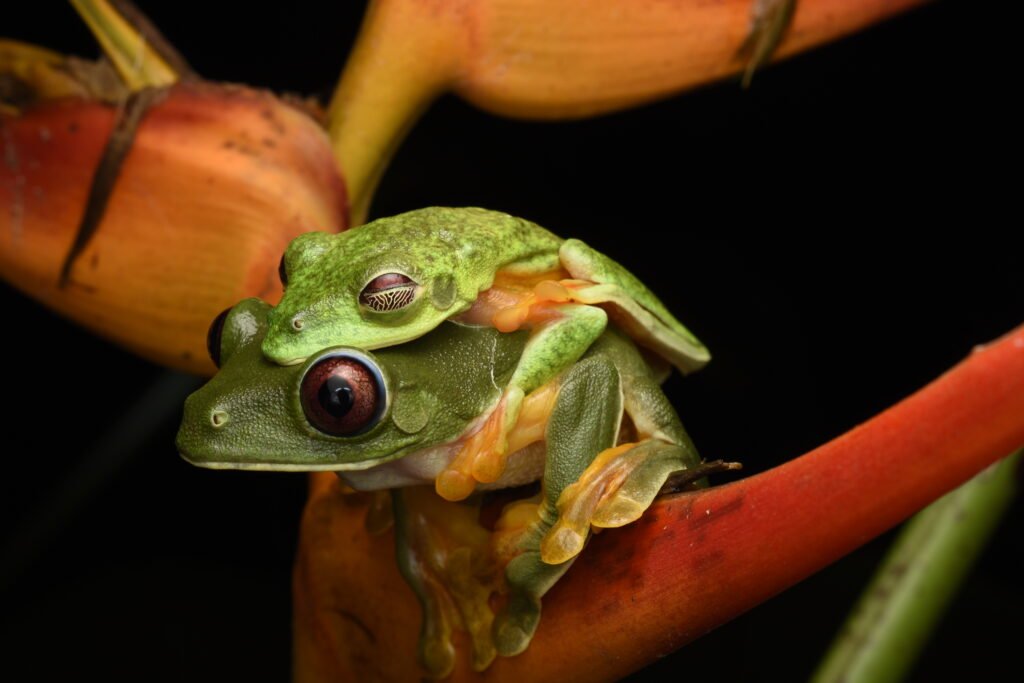
So you’ve got a flock of chickens and a beautiful orchard filled with fruit trees, and you’re wondering how to bring these two together without any harm coming to your leafy friends. It may seem like a tricky endeavor, but fear not! There are actually some simple and effective ways to introduce chickens to fruit trees without causing any damage. In this article, we will explore some clever strategies that will help you keep your trees safe while enjoying the benefits of having chickens roam freely in your orchard. Let’s take a closer look at how you can make this harmonious coexistence a reality.

Choosing the Right Breed of Chickens
When it comes to introducing chickens to your fruit trees, one of the most important aspects to consider is the breed of chickens you choose. Different breeds have different characteristics that can greatly impact their compatibility with an orchard setting.
Consider the Size of the Breed
First and foremost, you need to consider the size of the breed. Opting for smaller or medium-sized breeds is often recommended when introducing chickens to an orchard. Larger breeds may potentially cause damage to the trees due to their foraging behavior. Smaller breeds, on the other hand, are less likely to cause significant harm.
Look for Docile and Calm Temperament
In addition to size, the temperament of the breed is also crucial. Look for breeds that are known for their docile and calm personalities. These chickens are less likely to become overly active or aggressive towards the trees, reducing the risk of damage. Some examples of docile breeds include Australorps, Orpingtons, and Brahmas.
Consider Dual-Purpose Breeds
Another factor to consider is whether you want your chickens to serve a dual purpose, such as providing both eggs and meat. Opting for dual-purpose breeds allows you to reap the benefits of fresh eggs while still having the chickens help with orchard maintenance. Breeds like Rhode Island Reds and Sussex are excellent choices in this regard.
Preparing the Fruit Trees
Before introducing chickens to your orchard, there are a few essential preparations to undertake to ensure the trees remain healthy and undamaged.
Pruning the Trees
Pruning is a crucial step in preparing your fruit trees for the presence of chickens. It involves removing any dead or damaged branches, as well as ensuring proper airflow and light penetration throughout the tree. By pruning the trees, you reduce the risk of chickens causing unnecessary harm when moving around and exploring the orchard.
Securing Low-Hanging Branches
Once you have pruned the trees, it’s important to secure any low-hanging branches. Chickens are natural foragers and may be tempted to peck at the lower hanging fruits or branches. Use tree ties or other tree support systems to lift up these branches slightly, making them less accessible to the chickens. This helps protect your fruit crop and prevents damage to the trees.
Protecting Young Trees
If you have young or newly planted fruit trees, take extra precautions to protect them. Consider putting up small physical barriers, such as wire mesh or tree guards, around the base of these trees. This prevents the chickens from scratching or pecking at the delicate young tree trunks, ensuring they can grow without interference.

Creating Temporary Fencing
To control the movement of the chickens within the orchard and prevent them from accessing certain areas, creating temporary fencing is a practical solution.
Determine the Fencing Area
First, you need to determine the specific area you want to allocate for the chickens within the fruit orchard. Consider the size of your orchard and calculate how much space is suitable for the number of chickens you plan to have. It’s essential to provide enough room for them to move freely and engage in natural behaviors.
Choose the Type of Temporary Fencing
Once you have determined the area, consider the type of temporary fencing that will work best for your situation. Options include chicken wire, electric netting, or portable electric fencing. Chicken wire is a cost-effective choice if you don’t need to worry about predators, while electric netting provides both a physical barrier and a deterrent for animals trying to enter or exit the designated area.
Secure the Fencing Properly
Properly securing the temporary fencing is crucial to ensure the chickens stay within their allocated space. Make sure the fencing is installed firmly in the ground or properly anchored to prevent the chickens from knocking it over or squeezing under it. Regularly inspect the fencing for any signs of damage or weak spots and repair them promptly to maintain a secure boundary.
Introducing the Chickens to the Orchard
Introducing the chickens to the orchard requires a thoughtful approach to ensure their safety and to minimize any potential tree damage.
Gradual Introduction
When introducing chickens to the orchard for the first time, it’s important to do so gradually. Begin by allowing them access to a small, fenced-off portion of the orchard. This helps them acclimate to the new environment while preventing them from becoming overwhelmed or disoriented. After observing their behavior and ensuring they are comfortable, gradually expand their access to the rest of the orchard.
Supervising the Chickens
During the initial introduction period, it’s crucial to supervise the chickens closely. Keep an eye on their behavior and interactions with the trees. This allows you to address any potential issues or destructive behavior immediately. By being present during their early interactions, you can reinforce positive behavior and discourage any negative tendencies.
Monitoring their Behavior
Even after the initial introduction period, it’s important to continue monitoring the chickens’ behavior within the orchard. Regularly observe them to ensure they are not causing any harm to the trees or engaging in destructive behavior. This ongoing monitoring allows you to quickly address any issues and modify their access or behavior accordingly.

Providing Adequate Food and Water
Proper nutrition and access to fresh water are essential for the health and well-being of your chickens. Ensuring they have adequate food and water within the orchard encourages them to focus their foraging activities in the designated area.
Ensuring Proper Nutrition
To provide your chickens with proper nutrition, consider planting some cover crops or adding chicken-friendly plants within the designated orchard area. These plants can serve as natural forage, allowing the chickens to graze on insects, worms, and vegetation. Additionally, providing a balanced chicken feed that meets their nutritional needs is crucial. Consult with a poultry nutrition expert to select the right feed for your chickens.
Placing Feed and Water Stations
To make feeding easier for both you and your chickens, install feed and water stations within the orchard area. Place them strategically to encourage the chickens to spend more time near the trees they are meant to be protecting. Ensure the feed and water stations are kept clean and regularly replenished to guarantee a continuous supply of food and water.
Regularly Checking and Refilling
Maintain a routine of regularly checking and refilling the feed and water stations within the orchard. This not only ensures the chickens have access to fresh resources but also allows you to regularly assess the chickens’ presence in the area. Monitoring their consumption patterns can help detect any changes in their behavior or potential health issues.
Implementing Chicken-Friendly Orchard Management Practices
By adopting chicken-friendly orchard management practices, you can create a harmonious environment where both the chickens and the fruit trees thrive.
Avoiding Chemical Pesticides
One of the most critical aspects of chicken-friendly orchard management is avoiding the use of chemical pesticides. Chickens can be sensitive to harmful chemicals, and their consumption can negatively impact their health and egg production. Instead, consider using organic pest control methods, such as neem oil sprays or introducing beneficial insects, to naturally manage pests.
Mulching and Composting
Mulching is an effective technique to increase soil moisture, control weed growth, and protect the tree roots. Use organic mulch materials, such as straw or wood chips, around the base of the fruit trees. This not only benefits the trees but also creates a favorable environment for the chickens. Similarly, composting organic materials from the orchard, such as fallen leaves or fruit scraps, provides a nutrient-rich soil amendment and can help attract insects for the chickens to forage.
Providing Dust Bathing Areas
Chickens require dust bathing to maintain their feather health and control pests. Provide designated dust bathing areas within the orchard by creating shallow depressions filled with loose soil or sand. These areas allow the chickens to engage in their natural behavior while minimizing soil disturbance around the trees.
Protecting the Trees
While chickens can play a beneficial role in orchard management, it’s important to protect the trees themselves to ensure their growth and productivity.
Using Tree Guards
To protect your fruit trees from scratching or pecking damage caused by chickens, consider using tree guards. These are physical barriers placed around the base of the tree trunk to prevent direct contact with the chickens. Tree guards can be made of wire mesh, plastic tubing, or other protective materials. Regularly inspect the guards and make any necessary adjustments or replacements as the trees grow.
Netting the Fruit
If you want to ensure a bountiful harvest, especially if you have fruit-bearing trees, consider using netting to protect the fruit from the chickens. Netting creates a barrier preventing the chickens from reaching the fruit while still allowing sunlight and airflow. Secure the netting properly to avoid entanglement or any potential hazards.
Practicing Proper Pruning Techniques
Regular pruning is essential for maintaining the health and shape of the fruit trees. However, it’s important to practice proper pruning techniques to minimize potential damage caused by the chickens. Avoid pruning during times of year when the chickens are most active and ensure that any pruned branches are properly removed from the chickens’ access.
Encouraging Natural Pest Control
One of the major benefits of introducing chickens to your orchard is their ability to control pests organically.
Allowing Chickens to Search for Insects
Chickens are natural insect hunters and can play a valuable role in reducing pest populations within the orchard. Allow them ample time to search for insects by giving them free access to the fruit tree area. Their foraging behavior will help control pests while providing them with a natural and engaging activity.
Encouraging Roosting in Trees
Chickens naturally seek elevated areas to roost at night. Encourage them to roost in the fruit trees by providing safe and comfortable perches. This not only keeps them away from potential predators on the ground but also allows them to directly deter pests that may attack the trees.
Introducing Beneficial Insects
In addition to utilizing chickens, consider introducing beneficial insects to the orchard ecosystem. Ladybugs, lacewings, and parasitic wasps are examples of insects that can help control pests naturally. These beneficial insects can aid in controlling pests that chickens may not eat, creating a more comprehensive pest management system.
Managing Waste and Maintaining Hygiene
Proper waste management and hygiene practices are vital when chickens are introduced to an orchard setting.
Designating a Manure Area
To manage chicken waste efficiently, designate a specific area within or adjacent to the orchard for manure collection. Regularly clean this area and compost the manure to produce nutrient-rich fertilizer for the fruit trees. Properly managing the manure not only maintains hygiene within the orchard but also ensures the waste does not accumulate near the trees, preventing potential damage.
Regularly Cleaning the Orchard
Maintaining a clean orchard environment is crucial for both the health of the fruit trees and the chickens. Regularly remove fallen fruit, leaves, and other debris from the orchard floor. This helps minimize potential disease and pest problems, creates a cleaner foraging environment for the chickens, and reduces the risk of contamination from waste.
Using Deep Litter Method
Consider implementing the deep litter method within the designated chicken area of the orchard. This involves regularly adding organic material, such as straw or sawdust, to the chicken bedding. The deep litter method effectively composts the waste over time, provides insulation for the chickens, and prevents strong odors. Rotate and remove the deep litter periodically to maintain a healthy coop environment.
Addressing Potential Challenges
While introducing chickens to the orchard can be beneficial, there are potential challenges to be aware of and address.
Preventing Excessive Soil Disturbance
Chickens are known to scratch and dig in the soil, which can lead to excessive soil disturbance. To prevent this, regularly monitor the soil condition around the trees and re-mulch as needed to discourage digging. Providing alternative dust bathing areas and ensuring adequate forage can also help divert their natural digging behavior.
Managing Chicken Behavior
It’s essential to manage chicken behavior to prevent any destructive habits from developing. This includes discouraging destructive pecking or scratching behavior towards the trees. One way to manage their behavior is through positive reinforcement, rewarding good behavior, and redirecting any problematic behavior. Consistent training and providing adequate enrichment can help keep their behaviors in check.
Protecting Trees from Scratching
To prevent chickens from scratching at the base of the trees, consider using tree wraps or applying deterrents like sticky substances that make tree trunks less appealing to the chickens. Additionally, providing alternative scratching areas, such as designated sandboxes or logs, can redirect their scratching behavior away from the trees.
In conclusion, introducing chickens to your fruit trees can be a win-win situation. The chickens provide natural pest control, assist in orchard management practices, and even offer fresh eggs. By choosing the right breed, preparing the trees, creating temporary fencing, and implementing proper orchard management practices, you can successfully introduce chickens to your orchard without damaging the trees. With careful planning and ongoing monitoring, you can create a symbiotic relationship where the chickens thrive, and the fruit trees flourish.





